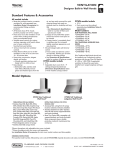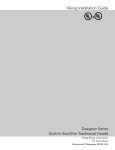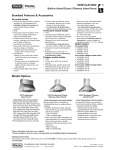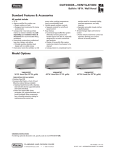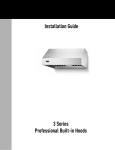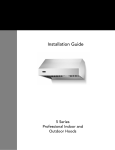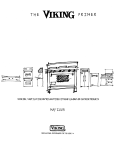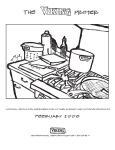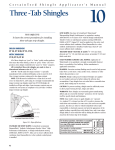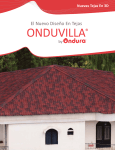Download Viking Range Designer Series Installation guide
Transcript
Viking Installation Guide Designer Series Built-In 18” H. Hoods Viking Range Corporation 111 Front Street Greenwood, Mississippi 38930 USA NOTE: IF INSTALLING HOOD WITH WARMING SHELF PANEL, INSTALL WARMING SHELF PANEL FIRST. WARNING TO REDUCE THE RISK OF FIRE, ELECTRICAL SHOCK, OR INJURY TO PERSONS, RANGEHOODS MUST BE INSTALLED WITH THE VENTILATORS THAT ARE SPECIFIED ON THEIR CARTON INDICATING SUITABILITY WITH THIS MODEL. OTHER VENTILATORS CANNOT BE SUBSTITUTED. IMPORTANT - PLEASE READ AND FOLLOW •Before beginning, please read these instructions completely and carefully. •Do not remove permanently affixed labels, warnings, or plates from the product. This may void the warranty. •Please observe all local and national codes and ordinances. If no local codes are applicable, wire in accordance with the National Electrical Code, ANSI/NFPA 70-1990. WARNING TO REDUCE THE RISK OF FIRE, ELECTRICAL SHOCK, OR INJURY TO PERSONS, OBSERVE THE FOLLOWING: 1. Installation work and electrical wiring must be done by qualified person(s) in accordance with all applicable codes and standards, including fire-rated construction. 2. Sufficient air is needed for proper combustion and exhausting of gases through the flue (chimney) of fuel burning equipment to prevent back drafting. Follow the heating equipment manufacturer’s guideline and safety standards such as those published by the National Fire Protection Association (NFPA), and the American Society for Heating, Refrigeration and Air Conditioning Engineers (ASHRAE), and the local code authorities. 3. When cutting or drilling into wall or ceiling, do not damage electrical wiring and other hidden utilities. 4. Ducted fans must always be vented to the outdoors. 5. WARNING!: To reduce the risk of fire, use only metal ductwork. 6. CAUTION!: To reduce risk of fire and to properly exhaust air, be sure to duct air outside. Do not vent exhaust air into spaces within walls or ceilings, or into attics, crawl spaces, or garages. •Check with a qualified and trained installer or local codes for makeup air requirement, if any. The installer should leave these instructions with the •T consumer who should retain for local inspector’s use and for future reference. This hood is for residential installation only and is not designed for installation over a commercial product. Make sure power is off at the main circuit breaker or fuse box before making connections. To avoid risk of fire, electric shock, or injury to persons, turn off the electricity to the hood from the power supply before servicing or cleaning. Viking Range hoods are equipped with variable speed controls for blowers. These units will not function with a single speed ventilator. All Viking Range ventilator kits are designed specifically for use with Viking Range hoods. Use of any non-Viking Range ventilator kit will void the hood warranty. WARNING TO REDUCE THE RISK OF A RANGETOP GREASE FIRE: 1. Never leave surface units unattended at high setting. Boilovers cause smoking and greasy spillovers that may ignite. Heat oils slowly on low or medium settings. 2. Always turn hoon ON when cooking at high heat or when cooking flaming foods. 3. Clean ventilating fans frequently. Grease should not be allowed to accumulate on fan or filter. 4. Use proper pan size. Always use cookware appropriate for the size of the surface element. CAUTION For general ventilating use only. Do not use to exhaust hazardous or explosive materials and vapors. 2 BASIC SPECIFICATIONS INTERIOR AND EXTERIOR POWER HOODS RECOM. DESCRIPTION CFM1 NUMBER OF HALOGEN LIGHTS (int.-interior; ext-exterior FILTERS 120VAC/60Hz SPACERS MAX. AMPS3 (Interior/Exterior) 18” H. Wall 30”W.* 36”W.* 42”W.* 48”W. 2 2 2 3 300 int/600 int./1200 int./900 ext./1200 ext. 300 int/600 int./1200 int./900 ext./1200 ext. 600 int./1200 int./900 ext./1200 ext. 1200 int./1200 ext./1500 ext. 2 2 3 3 0 1 0 0 2.4/4.6/6.6/6.6/3.9 2.4/4.6/6.6/6.6/3.9 4.6/6.6/6.6/4.0 7.0/4.3/5.1 *1200 CFM (or 1500 CFM if applicable) exterior ventilator should be used when installed over ranges/rangetops with gas grill. MODEL NUMBER For Use with hoods: APPROXIMATE CFM1 RECOMMENDED DUCT SIZE MAX. DUCT RUN2 (ft.) VIV300 (interior) 300 7” round 50 VIV600 (interior) 600 7” round 50 VIV1200 (interior) 1200 10” round 50 VEV900 (exterior) 900 10” round 50 VEV1200 (exterior) 1200 10” round 50 VEV1500 (exterior) 1500 10” round 75 PROPER INSTALLATION/DUCTING IS EXTREMELY IMPORTANT TO ENSURE MAXIMUM PERFORMANCE FROM ANY VENTILATION PRODUCT 1. •All CFMs stated are based on tests at .1 static pressure: without applying static pressure, CFM would be greatly overstated. 2. •Duct run length is for general reference only; for longer duct runs, increase duct size and contact a qualified and trained installer. •Straight runs and gradual turns are best; for example, each 90o elbow is equivalent to 5-10 feet (1.52 - 3.05 cm) of straight run. •Never use flexible duct; it creates back pressure/air turbulence and greatly reduces performance. •Proper performance is dependent upon proper ducting; make sure that a qualified and trained installer is used. •Check with a qualified and trained installer or local codes for makeup air requirement, if any. 3. •Max. amp rating for hoods includes recommended ventilator kit rating; all products must be hard wired direct with 2wire with ground. 3 HEIGHT OF HOOD The bottom of the hood should be 30” (76.2 cm) min. to 36” (91.4 cm) max. above the countertop. This would typically result in the bottom of the hood being 66” (167.6 cm) to 72” (182.9 cm) above the floor. For best performance, it is recommended that the bottom of the hood be 30” (76.2 cm) to 33” (83.8 cm) above the countertop. These dimensions provide for safe and efficient operation of the hood. Clearance Dimensions 18” (45.7 cm) 30” (76.2 cm) Min. 36” (91.4 cm) Max. Countertop 36” (91.4 cm) 4 PREPARING FOR HOOD INSTALLATION Plan where the ductwork will be located. See pages 8-11 for rough-in dimensions. Install proper-sized duct work, and roof or wall cap for the type of blower you are using. Recommended hood locations for the most common installations are shown on page 2. Exterior Blower Adjust your measurements for various heights of ceilings, soffits, cabinets, or ranges/rangetops. 10” Round Roof Cap Roof Cap Duct 10” Round duct 7” Round Duct 12” (30.5 cm) 12” (30.5 cm) Duct Cover or Soffit Duct Cover or Soffit Duct Cover or Soffit 300 or 600 CFM Interior-Power - Typical Ductwork 1200 CFM Interior-Power - Typical Ductwork 900, 1200, or 1500 CFM Exterior-Power - Typical Ductwork ELECTRICAL SUPPLY Run 120 VAC electrical power cable from service panel to installation location. See “Basic Specifications” on page 13 for the maximum amp requirements. INSTALLING HOOD CANOPY Center the wood strip (acquired locally - see drawing for dimensions) and attach to wall. Using the slot located on the backside of the canopy, place the hood onto the wood strip. Secure the hood to strip with mounting screws provided. Make sure that the wood strip mounting screws are driven into the framing and not just the drywall. Use additional mounting screws (and wall anchors if necessary) in the other holes. NOTE: BECAUSE OF THE WEIGHT OF THE HOOD - MAKE SURE THAT THE WOOD STRIP MOUNTING SCREWS ARE DRIVEN INTO THE FRAMING AND NOT JUST THE DRYWALL. IT MAY BE NECESSARY TO DRILL ADDITIONAL HOLES IN THE CANOPY FOR PROPER ALIGNMENT. Top Mounting Holes 113/16” (4.6 cm) Wood Strip (acquired locally- 11/2” x3/4”) 11/2” (3.8 cm) 3/4”(1.9 cm) Slot for Wood Strip Rear Mounting Holes 5 INSTALLING ROUGH-IN PLATE AND CONNECTING DUCT - INTERNAL POWER (Also see instructions supplied with ventilator kit) 1. Attach rough-in plate to studs in the inside, top of hood with four (4) #10-24 nuts provided. 2. Connect ductwork using supplied transition and damper (transition and damper are part of rough-in plate on some models). Use duct tape to make all joints secure and air tight. In some installations, it is easier to attach transition to plate before attaching plate to hood. 3. Remove wire box cover. Remove a knockout from the wiring box. Feed 6” of power cable through opening and attach cable to wiring in wiring box with appropriate connector. WARNING: MAKE SURE ELECTRICAL SUPPLY IS OFF. 4. Wire black to black, white to white, and green or bare wire beneath green ground screw. Replace wire box cover. Top of Hood Studs Studs Wire box cover Nuts Nuts Rough-in Plate 5. Plug the rough-in plate power cord into the receptacle located on the top side of the light panel. 3-prong power supply plug-in 2-prong blower plug-in Receptacles are located behind and above control panel 6 INSTALLING THE VENTILATORS VIV300 or VIV600 - Interior-Power Ventilator Kit (300 or 600 CFM) (also see instructions supplied with ventilator kit) 1. Make sure barrel nuts and wing nut are engaged halfway onto threaded stud. 2. Lift ventilator into canopy - may be easier to turn ventilator side ways to lift into canopy then rotate into mounting position. 3. Lift ventilator allowing barrel nuts to come through large end of keyhole opening. Rough-in 4. Slide ventilator to the right, engaging barrel Plate nuts into small end of keyhole openings and engaging studs with wing nut in slot on right side of ventilator. Make sure discharge openings match. 5. Tighten barrel nuts and wing nut. 6. Plug the ventilator power cord into the receptacle located on the topside of the light panel. Top of Hood Studs Wingnut 600 CFM Blower Barrel Nuts Remove rear filter support before installing blower. After installation is complete, reinstall the rear filter support. VIV1200 - Interior-Power Ventilator Kit (1200 CFM) (also see instructions supplied with ventilator kit) 1. Make sure barrel nuts and wing nut are engaged halfway onto threaded stud. 2. Lift ventilator into canopy - may be easier to turn ventilator side ways to lift into canopy then rotate into mounting position. 3. Engage tab on ventilator with slot in rough-in plate AND engage slot in ventilator with barrel nut on threaded stud. 4. Push ventilator towards the back of hood to fully engage. 5. Use a long, flat-head screwdriver to tighten the barrel nut securely. 6. Plug the ventilator power cord into the receptacle located on the topside of the light panel. 9” (22.9 cm) Transition Top of Hood Studs Slot Rough-in Plate 1200 CFM Blower Barrel Nut Remove rear filter support before installing blower. After installation is complete, reinstall the rear filter support. 7 INSTALLING ROUGH-IN PLATE AND CONNECTING DUCT -EXTERNAL POWER (Also see instructions supplied with ventilator kit) 1. Run 10” round steel ductwork, from exterior blower to the installationlocation. For best performance, use the straightest possible duct run and the fewest number of elbows. Tape all joints. 2. Run 120 VAC electrical power cable from service panel and from remote blower to installation location. 3. Remove wiring box cover. Remove knockouts from the wiring box. Feed 6” of power cable through the openings and attach cables to wiring box with appropriate connectors. 4. Wire black to black, white to white, and green or bare wire beneath green ground screw. Replace wiring box cover. 5. Attach rough-in plate to the studs at the inside 10” (25.4 cm) Round Duct top of hood with (4) #10-24 nuts provided. 6. Connect ductwork to rough-in plate and tape joint. 7. Plug the rough-in plate power cord into the receptacle located on the top side of the light panel. Wire from breaker goes to three prong female plug. Wire from blower goes to two prong male plug Receptacles are located behind and above control panel 3-prong power supply plug-in 2-prong blower plug-in 8 ROOF CUTOUT ROOF INSTALLATION EXTERIOR-POWER VENTILATOR 203/4” (52.7 cm) VEV/dev900-Exterior Power Ventilator Kit (900CFM) (also see instructions supplied with ventilator kit) 1. Locate the blower on the rear slope of the roof. Place it in a location to minimize duct run. The location should be free of obstacles (T.V. leads, electrical lines, etc.). Bear in mind, if the blower top is level with the roof peak, it will not be seen from the street. Keep this approximate location in mind as you work from within the attic. 2. Mark a point halfway between rafters. 3. Drill a guide hole through the roof at this point. 4. From the outside, use the guide hole as a starting point. A. Use a T-square to measure 81/2” (21.6 cm) to the left of the guide hole, then down 103/8” (26.4 cm) to locate the bottom left corner of the layout. B. Mark the rectangular cutout and remove only the shingles in this area. 5. Mark an 11” (27.9 cm) diameter circle centered on the guide hole and mark the center of the 11/4” (3.2 cm) diameter electrical wiring hole. 6. Cut out the roof board(s) along the 11” (27.9 cm) diameter circle and drill a 11/4” hole as marked. 7. For flat roof installations, build a curb that will mount the blower at a minimum pitch of 2/12. Discharge end of the blower should be pointed away from prevailing winds. 8. Remove roofing nails from the upper two-thirds of the shingles around the cutout area. Carefully lift the shingles to allow the back flashing sheet on the blower housing to fit under them. 9. Center the blower ring in the 11” (27.9 cm) diameter hole, making sure that the 11/4” (3.2 cm) diameter electrical wiring hold aligns with the hole in the wiring box. 10. Attach the blower to the roof with the six screws provided. It is recommende that the screws be located inside the blower housing. All six holes in the back panel must be filled, or any moisture that may get inside the housing could leak into the house. 11. Using a good grade of roofing cement, seal all of the shingles around the housing and flashing sheet as well as the mounting screw heads. 12. Bring electrical wiring through the hole in the wiring box and secure it according to local codes. 13. Make the electrical connections with the proper connector for the type of wiring being used. Connect white to white, black to black, and the green or bare wire to green. 14. Replace wiring box cover and screws. Do not pinch wiring under the cover. 15. Check for free movement of the damper before installing housing cover and screws. 16. Turn on power and check operation of the blower. 81/2” (21.6 cm) 11” (27.9 cm) dia. hole REMOVE SHINGLES 103/8” (26.4 cm) Guide Hole 201/2” (52.1 cm) 91/8” (23.2 cm) 71/4” (18.4 cm) 11/4” (3.2 cm) dia. hole 2”(5.1 cm) 28 1/4” (71.8 cm) 6 3/4” (17.1 cm) 25” (63.5 cm) 2”(5.1 cm) Black to Black 120 VAC Line In 9 Green to Green White to White WALL INSTALLATION EXTERIOR-POWER VENTILATOR WALL CUTOUT VEV900-Exterior-Power Ventilator Kit (900CFM) 1. Choose a position on the outside wall. Min. 24” (61.0 cm from ground may vary depending on local codes or location. Make sure that no wall studs, pipes or wires run through the opening area. 2. Drill a guide hole at the center of the opening area. 3. From the outside, use the guide hole as a starting point to lay out the installation. A. Use a T-square to measure 103/4” (27.3 cm) to the left of the guide hole, then 127/8” (32.7 cm) to locate the top-left corner of the layout. B. Starting from the top -left corner, mark a 25” (63.5 cm) by 281/2” (72.4 cm) rectangle on wall located from guide hole. 4. Cut a rectangular hole in the siding only. Do not cut the sheathing. Nail down all siding ends. 5. Mark an 11” (27.9 cm) diameter circle centered on the guide hole and mark the center of the 11/4” diameter electrical wiring hole. 6. Cut the 11” (27.9 cm) hole in the sheathing and drill the 11/4”(3.2 cm) as marked. 7. Place a large bead of caulk on the back side of the housing along the outer edge. 8. Center the blower ring in the 11” (27.9 cm) diameter hole, making sure that the 11/4” (3.2 cm) diameter electrical wiring hole aligns with the hole in the wiring box. 9. Attach blower to the wall with the six screws provided. It is recommended that the screws be located inside the blower housing. All six holes in the back panel must be filled, or any moisture that may get inside the housing could leak into the house. 10. Using a good grade of caulk, seal all around the mounting screw heads. 11. Bring electrical wiring through the hole in the wiring box and secure it according to local codes. 12. Make the electrical connections with the proper connector for the type of wire being used. Connect white to white, black to black, and green or bare wire to green. 13. Replace wiring box cover and screws. Do not pinch wiring under cover. 14. Check for free movement of the damper before installing housing cover and screws. 15. Turn on power and check operation of the blower. 16. Top and side flanges of the back plate may be covered with trim strips. Do not block grill opening at bottom with trim. It will adversely affect performance of the blower. 10 25” (63.5 cm) 103/4” (27.3 cm) 11” (27.9 cm) dia. hole 12 7/8” (32.7 cm) Guide Hole 91/8” (23.2 cm) 28 1/4” (71.8 cm) 11/4” (3.2 cm) Dia. Hole 71/4” (18.4 cm) Black to Black 120 VAC Line In Green to Green White to White ROOF INSTALLATION EXTERIOR-POWER VENTILATOR 11/4” (3.2 cm) dia. hole ROOF CUTOUT B VEV1200-Exterior Power Ventilator (1200 CFM) (also see instructions supplied with ventilator kit) REMOVE 1. Locate the blower on the rear slope of the roof. S HINGLES Place it in a location to minimize duct run. The 12 11/16” location should be free of obstacles (T.V. leads, (32.2 cm) electrical lines, etc.). Bear in mind, if the blower top is level with the roof peak, it will not be seen from the street. Keep this approximate location in mind as you work from within the attic. 2. Mark a point halfway between rafters. 3. Drill a guide hole through the roof at this point. C 4. From the outside, use the guide hole as a starting point to lay out the installation. A. Use a T-square to measure 913/16” (24.9 cm) to the left of the guide hole, then 1211/16” (32.2 cm) to locate the top-left corner of the layout. B. Starting from the top-left corner, mark the rectangular cutout and remove only the shingles 291/2” in this area. (74.9 cm) 5. Mark an 11” (27.9 cm) diameter hole centered on the guide hole. Mark the center of the 11/4” (3.2 cm) diameter electrical wiring hole. 6. Cut out the roof board(s) along the 11” (27.9 cm) diameter circle and drill a 11/4” hole as marked. 7. For flat roof installations, build a curb that will mount the blower at a minimum pitch of 2/12. Discharge end of the blower should be pointed D away from prevailing winds. 8. Remove roofing nails from the shingles around the top and sides of the cutout area only. Carefully lift the shingles to allow the back flashing sheet on the A blower housing to fit under them. DEV1200 18” 9. Center the blower ring in the 11” (27.9 cm) (45.7 cm) diameter hole, making sure that the 1 ¼” (3.2 cm) DEV1500 21” diameter electrical wiring hold aligns with the hole (53.3 cm) in the wiring box. 10. Attach the blower to the roof with the six screws provided. It is recommended that the screws be located inside the blower housing. All six holes in the back panel must be filled, or any moisture that may get inside the housing could leak into the Ground to house. grounding 11. Using a good grade of roofing cement, seal all of screw the shingles around the housing and flashing sheet as well as the mounting screw heads. 12. Bring electrical wiring through the hole in the wiring box and secure it according to local codes. 13. Make the electrical connections with the proper connector for the type of wiring being used. Connect white to white, black to black, and the green or bare wire to green. 14. Replace wiring box cover and screws. Do not pinch wiring under the cover. 15. Check for free movement of the damper before installing housing cover and screws. 16. Turn on power and check operation of the blower. 11 20 1/2” (52.1 cm) 11” (27.9 cm) dia. hole A 2” (5.1 cm) 7” (17.8 cm) 2” (5.1 cm) B C D 15” (38.1 cm) 18” (45.7 cm) 9 13/16’ (24.9 cm) 12 5/8” (32.1 cm) 22” (55.9 cm) 25” (63.5 cm) Black to Black 120 VAC Line In White to Blue WALL INSTALLATION EXTERIOR-POWER VENTILATOR WALL CUTOUT B VEV1200-Exterior Power Ventilator Kit (1200 CFM) 1. Choose a position on the outside wall. Min. 24” (61.0 cm 11/4” (3.2 cm) from ground may vary depending on local codes or location. dia. hole Make sure that no wall studs, pipes or wires run through 11/16 14 the opening area. 2. From inside, mark and drill a guide hole at the center of (37.3 cm) the opening area. 3. From the outside, use the guide hoel as a starting point to lay out the installation. A. Use a T-square to measure 1113/16” (30.0 cm) to the left of the guide hole, then 1411/16” (37.3 cm) tolocate the top-left corner of the layout. B. Starting from the top-left corner, mark a 22” (55.9 cm) by 291/2” (74.9 cm) rectangle on wall located from guide hole. C 4. Cut a rectangular hole in the siding only. Do not cut the sheathing. Nail down all siding ends. A 5. Mark an 11” (27.9 cm) diameter circle centered on the 1 guide hole and mark the center of the 1 /4” diameter A electrical wiring hole. DEV1200 22” 6. Cut the 11” (27.9 cm) hole in the sheathing and drill the (55.9 cm) DEV1500 25” 11/4”(3.2 cm) as marked. (63.5 cm) 7. Place a large bead of caulk on the back side of the housing along the outer edge. 8. Center the blower ring in the 11” (27.9 cm) diameter hole, making sure that the 11/4” (3.2 cm) diameter electrical wiring hole aligns with the hole in the wiring box. 9. Attach blower to the wall with the six screws provided. All Ground to six holes in the back panel must be filled, or any moisture grounding that may get inside the housing could leak into the house. screw 10. Using a good grade of caulk, seal all around the mounting screw heads. 11. Bring electrical wiring through the hole in the wiring box and secure it according to local codes. 12. Make the electrical connections with the proper connector for the type of wire being used. Connect white to blue, black to black, and green or bare wire to grounding screw. 13. Replace wiring box cover and screws. Do not pinch wiring under cover. 14. Check for free movement of the damper before installing White housing cover and screws. Blue 15. Turn on power and check operation of the blower. 16. Top and side flanges of the back plate may be covered with trim strips. Do not block grill opening at bottom with trim. It will adversely affect performance of the blower. FILTER/SPACER INSTALLATION 1. Install spacer(s) in center of filters. 2. Number of spacers and mesh filters: Spacers - 36”W only Mesh Filters - Wall Hoods 30” W., 36” W., - 2 filters 42” W., 48” W. - 3 filters Mesh Filter 12 3” (7.6 cm) 29 1/2” (74.9 cm) 11” (27.9 cm) dia. hole B C 17” 11 13/16” (43.2 cm) (30.0 cm) 20” 14 5/8” (50.8 cm) (37.2 cm) Black to Black 120 VAC Line In to Filter Spacer EXTERIOR VENTILATOR DIMENSIONS DEV1200 DEV1500 VEV900 Opening for wiring 10” Dia. A 203/4” (52.7 cm) 3” (7. 6c m) 1 29 /2” (74.9 cm) 5” (12.7 cm) 281/4” (71.8 cm) 1 10 /8” 25.7 cm 14 13/16” (37.6 cm) 241/2” (62.2 cm) 151/2” (39.4 cm) 6 1/4 ” (15.9 cm) Opening for wiring 14” (35.6 cm) 3 1/2” (8.9 cm) 243/4” (62.9 cm) 10” (25.4 cm) Dia. 1 22 /8” (56.2 cm) 11 13/16” (30.0 cm) B Flashing 43/4” (12.1 cm) DEV1200 Flashing DEV1500 WIRING DIAGRAM EXTERIOR VENTILATOR 13 A B 18” 22” (45.7 cm) (55.9 cm) 21” 25” (53.3 cm) (55.9 cm) WALL HOOD DIMENSIONS tall traditional - ledgeless/ tall traditional - ledge Transition VIV1200 Only 9” (22.9 cm) 1 1/2” (3.8 cm) 1” (2.5 cm) 12” (30.5 cm) 1 1/2” (3.8 cm) 7/8” (2.2 cm) 18” (45.7 cm) 18” (45.7 cm) 24” (61.0 cm) 24” (61.0 cm) SIDE VIEW EXTERNAL POWER SIDE VIEW INTERNAL POWER B 18 3/4” (47.6 cm) *NOTE: VIV600 - 7” VIV1200 - 10” 8 1/4” (20.9 cm) 5 15/16” (15.1 cm) 6 7/16” (16.4 cm) 4 5/8” (11.7 cm) 9 1/8” (23.2 cm) 3” (7.6 cm) 9 3/4” (24.8 cm) 24” (61.0 cm) 9 3/8” 9 5/8” (23.8 cm) (24.4 cm) 2 1/2” (6.4 cm) A 30”W., 36”W., 42” W. EXTERNAL POWER - VEV900 or VEV1200 A 30”W., 36”W., 42” W. INTERNAL POWER - VIV300, VIV600, or VIV1200 A 30” 36” 42” 48” W. W. W. W. Models Models Models Models 29 35 41 47 B 7/8” (75.9 cm) 7/8”(91.1 cm) 7/8” (106.4 cm) 7/8” (121.6cm) 14 14 17 20 23 15/16” 15/16” 15/16” 15/16” (37.94 cm) (45.56 cm) (18.18 cm) (60.8 cm) 23 15/16” (60.8 cm) 23 15/16” (60.8 cm) 83/16” 5/8” (1.6 cm) (20.7 cm) 515/16” (15.1cm) 51/2” 65/8” (16.8 cm) 120 V 83/8” (14.0 cm) 120 V 3” (7.62 cm) 21/2”(6.35 cm) 91/4” 91/2” (23.5 cm) (24.1 cm) (21.3 cm) 183/4” (47.6 cm) 9 3/4” (25.4 cm) dia. cutout 47 7/8” (121.6 cm) 47 7/8” (121.6 cm) 48” W. INTERNAL POWER - VIV1200 48” W. EXTERNAL POWER - VEV1200 or VEV1500 WIRING DIAGRAM DESIGNER SERIES BUILT-IN HOODS REFER ONLY TO FEATURES EQUIPPED WITH THIS UNIT. 15 VIKING RANGE CORPORATION 111 Front Street Greenwood, Mississippi 38930 USA (662) 455-1200 For product information call 1-888-VIKING1 (845-4641) or visit the Viking Web site at vikingrange.com F20040L (PS1005VR)
















